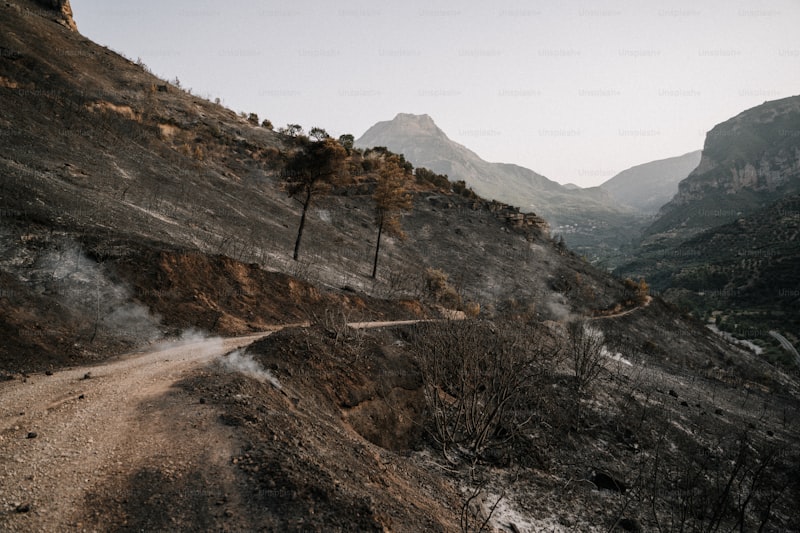Consider the aftermath of a tsunami—a colossal wave triggered by seismic activity underwater. It crashes ashore with devastating force, eroding beaches, inundating coastal towns, and depositing debris far inland. The impact is not merely physical but ecological, as entire ecosystems adapt or perish in the wake of such events.
In contrast, the slow, persistent force of erosion by wind and water patiently sculpts landscapes over eons. The Grand Canyon, a masterpiece of erosion, reveals layers of geological history carved by the Colorado River’s relentless flow. Similarly, wind-blown deserts like the Sahara showcase dunes sculpted into graceful arcs by the perpetual dance of grains of sand.
Natural disasters, while catastrophic, also play a role in the cycle of renewal. Forest fires, although destructive, clear away old growth, paving the way for new life to flourish. Floods deposit nutrient-rich sediments that rejuvenate soil, creating fertile grounds for future growth.
In essence, the Earth’s landscape is a canvas shaped by the unpredictable brushstrokes of natural disasters. Each event leaves behind a unique imprint, telling a story of resilience and adaptation in the face of nature’s awesome power. Understanding how natural disasters shape our world underscores the dynamic interplay between geological processes and the living ecosystems they support, a testament to the enduring forces that shape our planet’s ever-changing face.
Unveiling Nature’s Handiwork: How Natural Disasters Sculpt Earth’s Beauty
Have you ever marveled at the breathtaking landscapes that adorn our planet? From towering mountain ranges to serene coastlines, the Earth’s beauty is indeed a sight to behold. But did you know that much of this stunning scenery owes its existence to natural disasters?
Nature’s forces, often seen as destructive, play a pivotal role in shaping our planet’s natural wonders. Take, for instance, the majestic Grand Canyon. This awe-inspiring geological formation was carved over millions of years by the relentless flow of the Colorado River. What began as a small stream gradually etched its way through layers of rock, revealing the canyon’s intricate layers and vibrant colors.
Similarly, volcanic eruptions, though catastrophic in the short term, contribute to the creation of fertile soils and unique landscapes. The volcanic islands of Hawaii, with their lush vegetation and black sand beaches, stand as testament to nature’s ability to transform devastation into beauty.
Even earthquakes, with their terrifying power, have shaped the Earth’s surface in remarkable ways. The shifting tectonic plates have formed mountain ranges like the Himalayas and the Andes, offering habitats for diverse ecosystems and breathtaking vistas for travelers and adventurers alike.
In essence, natural disasters are not just random acts of destruction; they are intricate processes that sculpt the Earth’s canvas. They reshape coastlines, carve out valleys, and forge new landforms that inspire wonder and awe. Each disaster leaves behind a legacy of resilience and renewal, reminding us of nature’s indomitable spirit.
So, the next time you gaze upon a snow-capped peak or walk along a pristine beach, take a moment to appreciate the profound impact of natural disasters. They are not mere calamities but the master strokes of nature’s handiwork, painting the Earth in hues of beauty and grandeur.
From Chaos to Creation: The Transformative Power of Natural Disasters on Landscapes
Consider volcanic eruptions, where molten lava flows across previously untouched terrain, leaving behind a rugged, barren landscape. Over time, this scorched earth transforms as new life emerges from the nutrient-rich soil. Plants pioneer their way back, their growth catalyzed by the minerals deposited during the eruption. Gradually, what was once desolate becomes a thriving ecosystem, teeming with biodiversity.

Similarly, earthquakes, with their seismic power, can alter landscapes instantaneously. Mountains shift, valleys form, and coastlines are redefined. The upheaval leaves scars that, over time, nature heals with its resilience. Rivers find new paths, carving through rock formations, creating gorges that become havens for flora and fauna.

In coastal regions, the impact of hurricanes and tsunamis is profound. These powerful storms reshape shorelines, depositing sediments and rearranging ecosystems. Mangroves and coral reefs, though initially devastated, rebound with vigor, adapting to new conditions and fostering marine life diversity.
These natural phenomena, while disruptive, underscore the earth’s dynamic nature and its ability to regenerate. They remind us of nature’s capacity for creation amidst chaos, illustrating the cyclical relationship between destruction and renewal. Through these processes, landscapes evolve, offering new opportunities for exploration and scientific study.
Indeed, from chaos emerges creation—a testament to the transformative power of natural disasters on landscapes. As we study and appreciate these changes, we gain insights into the resilience of ecosystems and the intricate balance of life on earth. Nature, through its cycles of destruction and renewal, continues to shape our world in ways that captivate and inspire awe.
Nature’s Architect: Exploring the Artistry of Natural Disasters in Landform Creation
Have you ever marveled at the breathtaking landscapes sculpted by natural disasters? From towering mountains to deep valleys and rugged coastlines, these awe-inspiring features are not just random occurrences but masterpieces crafted by the powerful forces of nature. Natural disasters, often viewed with fear and awe, play a pivotal role in shaping our planet’s geography over millennia.

Take, for instance, the majestic Grand Canyon in Arizona, USA. Stretching over 277 miles and plunging depths of up to a mile, this colossal chasm is a testament to the erosive power of water. Over millions of years, the Colorado River relentlessly carved through layers of rock, exposing a geological timeline spanning millions of years. Each layer tells a story of ancient climates, ecosystems, and geological events, making the Grand Canyon not just a natural wonder but a living museum of Earth’s history.
Volcanic eruptions, another force of nature’s creativity, forge landscapes of stark beauty and fertility. Islands like Hawaii owe their existence to volcanic activity, with lava flows creating fertile soils that support unique ecosystems found nowhere else on Earth. The black sand beaches and lush rainforests of these volcanic islands are a testament to nature’s ability to create and sustain life in the most extreme environments.
But natural disasters aren’t just about destruction; they are about transformation and renewal. Forest fires, while devastating in the short term, clear away old growth and pave the way for new growth and biodiversity. The regenerative power of fire is essential for many ecosystems, allowing certain plant species to germinate and thrive under conditions created by the blaze.
From the sculpted peaks of the Himalayas to the swirling rock formations of Antelope Canyon, natural disasters continue to shape and redefine our planet’s landscapes in ways both profound and beautiful. Each cataclysmic event, whether earthquake, tsunami, or hurricane, leaves its mark on the Earth, creating a canvas of unparalleled diversity and resilience.
The Earth’s Canvas: A Visual Journey Through Landscapes Shaped by Natural Disasters
Have you ever wondered how natural disasters shape our planet’s breathtaking landscapes? From the fiery remnants of volcanic eruptions to the sculpted valleys carved by ancient floods, Earth’s canvas is a testament to the powerful forces at play. These landscapes tell stories of resilience and transformation, where destruction births beauty in unexpected ways.
Imagine standing on the edge of the Grand Canyon, its vastness a result of millions of years of erosion by the Colorado River. Each layer of rock whispers tales of time and patience, where water patiently carved through solid stone, leaving behind a masterpiece of jagged cliffs and deep crevices. It’s a reminder that nature’s artistry often unfolds slowly, yet with awe-inspiring results.
Volcanic eruptions, like those that formed Hawaii’s islands, paint a different picture. Molten lava, once a destructive force, cools and solidifies into fertile soil, nurturing lush green forests and black sand beaches. The contrast between destruction and rebirth is vivid here, showing how even the fiercest forces of nature can give rise to new beginnings.
Travel to the Badlands of South Dakota, where wind and water have sculpted soft clay-rich layers into rugged peaks and deep gullies. This starkly beautiful landscape is a testament to the patience of erosion, where every rainfall and gust of wind leaves its mark. It’s a living canvas, evolving slowly over millennia, inviting us to ponder the impermanence of even the most solid forms.
In Iceland, geothermal activity shapes the land, creating steaming hot springs and bubbling mud pots amidst icy glaciers. Here, the Earth’s inner heat meets its icy surface, creating a surreal juxtaposition of fire and ice. It’s a reminder that beneath the tranquil surface lies a restless planet, constantly reshaping itself in ways both subtle and dramatic.
From the towering peaks of the Himalayas to the serene fjords of Norway, natural disasters have sculpted landscapes that captivate and inspire. Each vista tells a tale of upheaval and adaptation, where the Earth’s resilience shines through. These landscapes are not just scenery; they are windows into the Earth’s history, inviting us to marvel at its power and beauty.
Rebirth Through Destruction: How Natural Disasters Renew and Reshape Our World
Natural disasters, despite their devastating impact, often reveal a paradoxical truth: they can catalyze profound renewal and transformation in our world. When nature’s fury strikes, it may seem like chaos reigns supreme, yet amidst the destruction lies an innate power to rejuvenate and reshape. This phenomenon of rebirth through destruction is a testament to nature’s resilience and its ability to forge new paths.
Consider the aftermath of a wildfire or a hurricane. These events leave behind a trail of destruction, altering landscapes and communities in their wake. However, from the ashes of a wildfire emerges a landscape enriched with nutrients, fostering the growth of new vegetation and revitalizing ecosystems. Similarly, coastal areas ravaged by hurricanes undergo natural replenishment as sediment deposits enrich soil fertility and restore coastal habitats.
Moreover, natural disasters often prompt communities to reevaluate and fortify their infrastructure against future calamities. The rebuilding process becomes an opportunity to integrate sustainable practices and resilient designs, mitigating risks and enhancing preparedness. In essence, these events compel us to innovate and adapt, fostering a collective resilience that strengthens societal fabric.
Metaphorically speaking, natural disasters serve as a crucible through which communities undergo transformation. Like a blacksmith refining metal in the fire, adversity tempers and molds communities, fostering bonds and fortitude. This resilience, born from adversity, defines our ability not only to endure but to thrive in the face of uncertainty.
While natural disasters exact a heavy toll, they also bear the seeds of renewal and growth. They compel us to confront challenges head-on, fostering innovation, and fortitude. Thus, amidst the wreckage, there exists a profound opportunity for rebirth and renewal, reminding us of nature’s remarkable capacity to reshape and rejuvenate our world.
This article aims to capture the transformative impact of natural disasters while maintaining a conversational tone and engaging the reader with vivid imagery and metaphorical language.
Forging New Paths: How Natural Disasters Redefine Geography and Terrain
Imagine a coastline transformed overnight by a tsunami, where once-familiar beaches are now altered, leaving behind a new topography that challenges our understanding of geography. This is the profound impact of natural disasters—they do not just alter the physical environment but also redefine our maps and geographical boundaries.
Take volcanic eruptions, for instance. When molten lava emerges from the depths of the Earth, it flows relentlessly, consuming everything in its path. As it cools and solidifies, it forms rugged terrain that contrasts sharply with the surrounding landscape. This new terrain becomes a testament to nature’s power to create and destroy simultaneously.
Similarly, earthquakes can thrust the Earth’s crust upwards or downwards, creating mountains or valleys where none existed before. These sudden shifts in terrain can be drastic, altering the course of rivers, affecting habitats, and challenging human settlements that have adapted to a particular geography over centuries.
Hurricanes and typhoons, with their powerful winds and torrential rains, can reshape coastlines by eroding cliffs or depositing massive amounts of sediment. Barrier islands may disappear or emerge anew, forever changing the dynamics of coastal ecosystems and human activities like fishing and tourism.
Frequently Asked Questions
How do earthquakes influence the formation of landscapes?
Earthquakes influence landscape formation by causing shifts in the Earth’s crust, leading to the creation of mountains, valleys, and fault lines. These geological events reshape terrain through processes such as faulting, folding, and uplift, contributing to the diverse and dynamic landscapes we see today.
How do floods alter landscapes over time?
Learn how floods reshape landscapes over time, carving new channels, depositing sediment, and altering ecosystems. Understand the long-term impact of flood events on terrain and vegetation.
What are the main types of natural disasters that shape landscapes?
Learn about the primary types of natural disasters that significantly influence landscape formation.
What role do volcanoes play in shaping landforms during natural disasters?
Discover how volcanoes significantly alter landscapes during natural disasters, influencing landforms through volcanic eruptions, lava flows, and ash deposits.
Can hurricanes and cyclones reshape coastal landscapes?
Yes, hurricanes and cyclones can significantly reshape coastal landscapes through powerful winds, storm surges, and erosion. These natural phenomena can alter shorelines, create new landforms like barrier islands, and impact coastal ecosystems.



